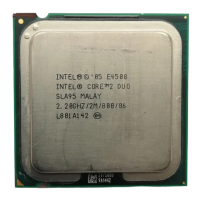Thermal Management
66 Datasheet
An external thermal sensor with a serial interface may be placed next to a SO-DIMM (or
any other appropriate platform location), or a remote Thermal Diode may be placed
next to the SO-DIMM (or any other appropriate platform location) and connected to the
external Thermal Sensor.
Additional external thermal sensor's outputs, for multiple sensors, can be wire-OR'd
together allow signaling from multiple sensors that are physically located separately.
Software can, if necessary, distinguish which SO-DIMM(s) is the source of the overtemp
through the serial interface. However, since the SO-DIMM's is located on the same
Memory Bus Data lines, any integrated graphics and memory controller-based read
throttle will apply equally.
Thermal sensors can either be directly routed to the integrated graphics and memory
controller PM_EXT_TS#[0] and PM_EXT_TS#[1] pins or indirectly routed to integrated
graphics and memory controller by invoking an Embedded Controller (EC) connected in
between the thermal sensor and integrated graphics and memory controller pins. Both
routing methods are applicable for both thermal sensors placed on the motherboard
(TS-on-Board) and/or thermal sensors located on the memory modules (TS-on-DIMM).
5.2.2.4 THERMTRIP# Operation
The integrated graphics and memory controller can assert THERMTRIP# (Thermal Trip)
to indicates that its junction temperature has reached a level beyond which damage
may occur. Upon assertion of THERMTRIP#, the integrated graphics and memory
controller will shut off its internal clocks (thus halting program execution) in an attempt
to reduce the core junction temperature. Once activated, THERMTRIP# remains latched
until RSTIN# is asserted.
5.2.2.5 Render Thermal Throttling
Render Thermal Throttling of the integrated graphics and memory controller allows for
the reduction the render core engine frequency and voltage, thus reducing internal
graphics controller power and integrated graphics and memory controller thermals.
Performance is degraded, but the platform thermal burden is relieved.
Render Thermal Throttling using several frequency/voltage operating points that can be
used to throttle the render core. If the temperature of the integrated graphics and
memory controller internal DTS exceeds the Hot-trip point, the integrated graphics will
switch to a lower frequency/voltage operating point. After a timeout, the DTS is
rechecked, and if the DTS temperature is still greater than the designed hysteresis, the
integrated graphics will continue to switch to lower frequency/voltage operating points.
Once the DTS reports a temperature below the hysteresis value, the render clock
frequency and voltage will be restored to its pre-thermal event state.
Caution: The Render Thermal Throttling must be enabled for the product to remain within
specification.

